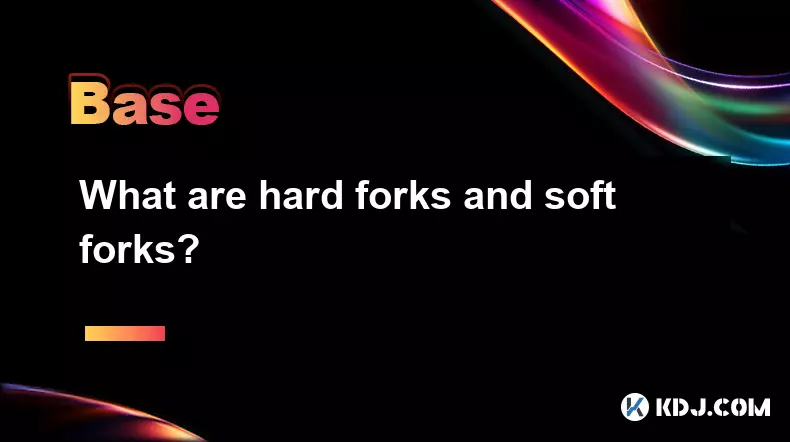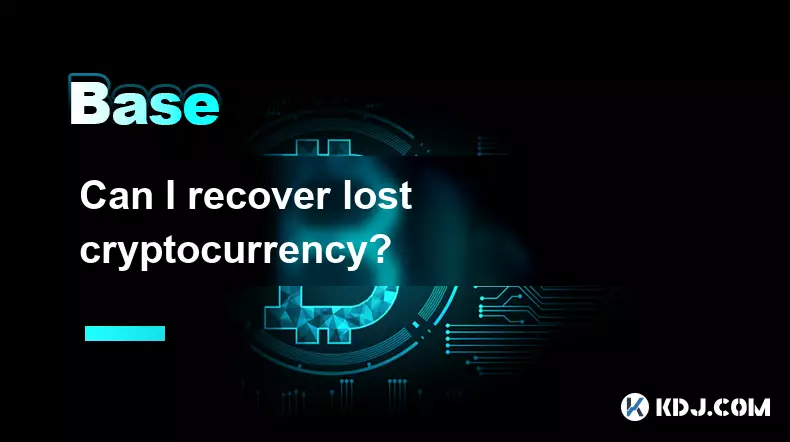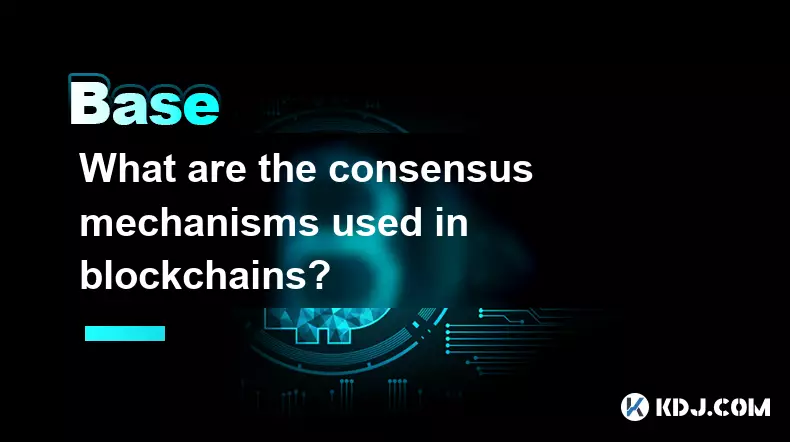-
 bitcoin
bitcoin $109667.069529 USD
-3.03% -
 ethereum
ethereum $3936.685804 USD
-4.07% -
 tether
tether $1.000493 USD
0.01% -
 xrp
xrp $2.771823 USD
-4.74% -
 bnb
bnb $957.805027 USD
-5.34% -
 solana
solana $196.735100 USD
-6.68% -
 usd-coin
usd-coin $0.999727 USD
-0.01% -
 dogecoin
dogecoin $0.227355 USD
-5.12% -
 tron
tron $0.335205 USD
-0.81% -
 cardano
cardano $0.779256 USD
-3.59% -
 ethena-usde
ethena-usde $0.999900 USD
-0.06% -
 hyperliquid
hyperliquid $42.492095 USD
-6.61% -
 chainlink
chainlink $20.501853 USD
-4.34% -
 avalanche
avalanche $28.952606 USD
-11.21% -
 stellar
stellar $0.356038 USD
-3.93%
What are hard forks and soft forks?
A hard fork splits a blockchain into two, creating a new cryptocurrency while giving original coin holders equal amounts on both chains.
Sep 27, 2025 at 12:01 am

Understanding Hard Forks in Blockchain Networks
1. A hard fork represents a permanent divergence in the blockchain ledger, creating two separate chains that operate under different rules. Once initiated, nodes running the old software will no longer recognize transactions from the updated chain unless they upgrade.
2. Hard forks often occur when developers seek to implement new features or fix critical security vulnerabilities that are incompatible with the existing protocol. This requires all participants to update their software to remain on the upgraded network.
3. The most notable example is the 2017 split of Bitcoin into Bitcoin and Bitcoin Cash. Disagreements over block size limits led a faction of the community to create a new chain supporting larger blocks.
4. Hard forks can lead to the creation of entirely new cryptocurrencies, giving holders of the original coin an equal amount on the new chain. This event often triggers market speculation and price volatility as traders assess the viability of both chains.
5. Because hard forks change consensus rules fundamentally, they require broad community support. Without widespread adoption, the new chain may fail to gain traction or suffer from low hash power, making it vulnerable to attacks.
The Role of Soft Forks in Protocol Upgrades
1. A soft fork is a backward-compatible upgrade to the blockchain’s protocol. Nodes that have not upgraded can still validate transactions, although they may not fully utilize new features.
2. Soft forks work by introducing stricter rules than those previously in place. For instance, reducing block size or adding new transaction types that legacy nodes treat as valid but do not interpret fully.
3. These upgrades typically require only a majority of miners to signal support before activation. Since older nodes remain compatible, the risk of chain splits is significantly reduced.
4. The Segregated Witness (SegWit) update on Bitcoin was implemented as a soft fork, allowing more transactions per block without forcing every user to upgrade immediately. It improved scalability and laid the groundwork for second-layer solutions like the Lightning Network.
5. Unlike hard forks, soft forks maintain network unity and reduce the likelihood of community fragmentation. They are preferred when possible because they minimize disruption while enhancing functionality.
Fork Initiatives Driven by Community and Developer Dynamics
1. Forks often emerge from ideological differences within a cryptocurrency’s ecosystem. Developers, miners, node operators, and users may disagree on governance, scalability approaches, or monetary policy.
2. When consensus cannot be reached through discussion, a portion of the community may choose to enforce change via a fork. This reflects the decentralized nature of blockchain networks where no single entity has absolute control.
3. Community-driven forks sometimes aim to return to original principles, such as decentralization and peer-to-peer electronic cash usage. Others focus on enabling smart contracts or improving privacy features.
4. Forks serve as mechanisms for innovation and experimentation, allowing alternative visions of a blockchain’s future to coexist. Projects like Ethereum Classic illustrate how some users value immutability even after major incidents like the DAO hack.
5. The success of a fork depends heavily on resource allocation—mining power, developer activity, exchange listings, and wallet support. Without these, even technically sound forks may struggle to survive.
Security Implications of Forking Events
1. Immediately following a fork, replay attacks become a concern. Transactions valid on one chain could be duplicated on the other, potentially leading to unintended transfers.
2. To mitigate this risk, developers often implement replay protection either before or shortly after the split. This ensures that signatures on one chain are invalid on the other.
3. New chains resulting from forks may face insufficient mining incentives, leading to lower difficulty and increased vulnerability to 51% attacks. Smaller networks are particularly at risk.
4. Exchange policies during forks also influence security; some platforms temporarily suspend deposits and withdrawals to prevent confusion and protect user funds. Users are advised to wait until clear distinctions between chains are established.
5. Wallet providers must update software to handle multiple assets post-fork. Failure to do so can result in loss of access to coins on either chain, especially if private keys are mishandled.
Common Questions About Blockchain Forks
What happens to my coins during a hard fork?In most cases, you retain ownership of the original cryptocurrency and receive an equivalent amount on the new chain. However, accessing the new coins may require using a wallet that supports the forked currency and taking specific technical steps.
Can a soft fork turn into a hard fork?Not inherently. A soft fork remains compatible with older nodes. If a group refuses to accept the new rules and continues mining under the old protocol, it could result in an unintentional hard fork, though this scenario is rare.
Do all nodes need to upgrade during a soft fork?No. One advantage of soft forks is backward compatibility. While upgraded nodes enforce new rules, un-upgraded nodes can still participate in the network, treating newer transactions as valid even if they don't understand all aspects.
How do exchanges handle forked tokens?Exchanges evaluate each fork based on technical stability, demand, and security. Some distribute new tokens to users, others list them for trading, and some ignore the fork entirely if deemed insignificant or risky.
Disclaimer:info@kdj.com
The information provided is not trading advice. kdj.com does not assume any responsibility for any investments made based on the information provided in this article. Cryptocurrencies are highly volatile and it is highly recommended that you invest with caution after thorough research!
If you believe that the content used on this website infringes your copyright, please contact us immediately (info@kdj.com) and we will delete it promptly.
- Riding the Crypto Wave: Ether Supercycle, Circle's Reversibility Debate, and Aster's DEX Surge
- 2025-09-27 02:45:12
- Shiba Inu's ETF Dreams: Navigating US Market Conditions
- 2025-09-27 03:05:12
- Dogecoin's Wild Ride: From Mining Moves to Meme Coin Mania – Can DOGE See 70x Growth?
- 2025-09-27 03:05:12
- Solana, Ruvi AI, and Institutional Backing: Navigating the Crypto Landscape
- 2025-09-27 02:25:16
- Momentum, Yield Campaigns, and Liquidity Expansion: Decoding the Latest Trends
- 2025-09-27 03:45:13
- Quant, CBDCs, and Crypto: Decoding the Future of Finance, Ya Heard?
- 2025-09-27 02:45:12
Related knowledge

What are some common methods of cryptocurrency market manipulation?
Sep 27,2025 at 02:55am
Wash Trading and Its Impact on Market Perception1. Wash trading involves an individual or entity simultaneously buying and selling the same cryptocurr...

Can I recover lost cryptocurrency?
Sep 25,2025 at 08:18am
Understanding the Nature of Cryptocurrency Loss1. Cryptocurrency operates on decentralized networks, meaning there is no central authority to reverse ...

How can I earn passive income from cryptocurrency?
Sep 23,2025 at 10:18am
Staking Cryptocurrencies for Regular Returns1. Many blockchain networks operate on a proof-of-stake (PoS) consensus mechanism, allowing users to earn ...

What are gas fees in cryptocurrency transactions?
Sep 26,2025 at 02:00am
Understanding Gas Fees in Blockchain Transactions1. Gas fees are payments made by users to compensate for the computing energy required to process and...

What are the consensus mechanisms used in blockchains?
Sep 24,2025 at 10:00am
Proof of Work and Its Role in Blockchain Security1. Proof of Work (PoW) is one of the earliest consensus mechanisms, first implemented by Bitcoin. Min...

How do cryptocurrencies impact traditional finance?
Sep 26,2025 at 05:54am
Disruption of Centralized Banking Systems1. Cryptocurrencies challenge the authority of central banks by offering decentralized alternatives to fiat c...

What are some common methods of cryptocurrency market manipulation?
Sep 27,2025 at 02:55am
Wash Trading and Its Impact on Market Perception1. Wash trading involves an individual or entity simultaneously buying and selling the same cryptocurr...

Can I recover lost cryptocurrency?
Sep 25,2025 at 08:18am
Understanding the Nature of Cryptocurrency Loss1. Cryptocurrency operates on decentralized networks, meaning there is no central authority to reverse ...

How can I earn passive income from cryptocurrency?
Sep 23,2025 at 10:18am
Staking Cryptocurrencies for Regular Returns1. Many blockchain networks operate on a proof-of-stake (PoS) consensus mechanism, allowing users to earn ...

What are gas fees in cryptocurrency transactions?
Sep 26,2025 at 02:00am
Understanding Gas Fees in Blockchain Transactions1. Gas fees are payments made by users to compensate for the computing energy required to process and...

What are the consensus mechanisms used in blockchains?
Sep 24,2025 at 10:00am
Proof of Work and Its Role in Blockchain Security1. Proof of Work (PoW) is one of the earliest consensus mechanisms, first implemented by Bitcoin. Min...

How do cryptocurrencies impact traditional finance?
Sep 26,2025 at 05:54am
Disruption of Centralized Banking Systems1. Cryptocurrencies challenge the authority of central banks by offering decentralized alternatives to fiat c...
See all articles










































































